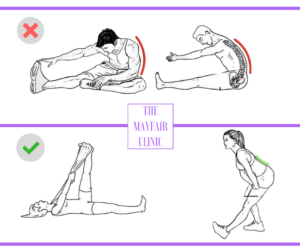What Is Sciatica?
Sciatica is a condition that is characterized by pain going down the leg (following the course of the sciatic nerve). Typically this can range from pain in the buttocks, extending down the back of the leg all the way to the back of the lower leg and into the foot. True Sciatica is more of a linear pain, one which could be traced with a pen and often described as “electric”.
The Sciatic Nerve is fed by a number of small nerve roots, which can become inflamed and irritated if the low back is injured or damaged in some way (repetitive stress or traumatic). There is also a small muscle known as piriformis, which is often referred to as a cause of sciatica and has been given its own “syndrome”, however in our opinion, the research is mixed and of insufficient quality or consistency to support this as a real diagnosis.
Common Causes of Sciatica
- Lumbar Slipped Disc
- Degenerative Disc Disease:
- Spondylolisthesis
- Spinal Stenosis
Common Symptoms of Sciatica
- Constant pain in only one side of the buttock or leg (rarely in both legs)
- Pain that is worse when sitting
- Leg pain that described as burning, tingling, or searing
- Weakness, numbness, or difficulty moving the leg, foot, and/or toes
- Difficulty walking because of the pain
What Is Not Sciatica?
In our experience, true sciatica is actually not all that common. Many cases of pain down the back of the leg are dismissed as sciatica without any real investigation, and although the pain is in the back of the leg, it is not actually sciatica. One thing we have learned is: that it is very important when prescribing our specialist treatment, that we understand what the problem is. All too often we have seen patients that have a wrong diagnosis, and this leads to substandard results when treating.
When Is Sciatica An Emergency?
If your sciatica progresses significantly or gives symptoms in both legs and around the “saddle area” such as numbness, you should seek emergency medical attention. In addition to this, if you experience any loss of continence this would be classified as an emergency as you could be experiencing “cauda equina syndrome“.
How Long Does Sciatica Last?
It can vary, but sciatica that lasts longer than 8 weeks is classified as chronic. We would always recommend, that at the first knowledge of symptoms, action should be taken. If you feel confident and symptoms are mild, self-help options should be attempted. However, if you do not feel comfortable with self-help, it is better to be safe and contact us. When caught early, a small number of treatments may be all that is necessary to relieve the pain. The treatment at The Mayfair Clinic is focused on accelerated healing, and so getting to the problem while it is still acute is great for ensuring and speeding up the healing process. This dramatically reduces the risks of future episodes.
Sciatica Treatment At Home
If you feel up to it, self-help treatment at home, as a first aid, is advisable. However, if symptoms do persist a couple of days, it is always best to seek professional help & book an appointment (here). Below are some exercises and stretches that could prove useful, however, be careful as doing them wrong will likely leave you worse off – especially if the underlying cause is not yet established.
Stretches for Sciatica
Below are a few stretches to help ease some of the pain associated with sciatica, we have included the wrong way as well! Just to help make sure you don’t fall into the trap!

Exercises to Help Sciatica
One of the best ways to help sciatica from an exercise point of view is to exercise in a way that reduces the chances of getting sciatica, good core stabilization exercises are the best way to do this. Protecting the Low back from inflammation and irritation that in turn causes sciatica as we discovered earlier.
We have a selection of exercises here which could help you but make sure you consider the principles in the picture above, some of these exercises may not be right for you if in doubt, ASK!
How To Treat Sciatica (if self-help doesn’t work)
The best way to treat sciatica is to treat the cause of sciatica. Medicating to reduce your brain’s perception of the pain is not rational as a complete treatment unless the cause cannot be addressed. First and foremost, the cause should be identified, and inflammation reduced and pain reduced. This is where examination and diagnosis come in. Exercising an injured tissue is not clever, so any exercise based physiotherapy in our opinion is most certainly not the right thing to do initially. Treatment is targeted at the diagnosed structures, and in chronic cases referral for X-Rays later on in a course of treatment is common. This gives us a unique insight into some risk factors for your spine and allows the tailoring of exercises to be more specific to you, the unique patient. (this is the point at which exercises become relevant and useful)
Treatment is targeted at the diagnosed structures, and in chronic cases referral for X-Rays later on in a course of treatment is common. This gives us a unique insight into some risk factors for your spine and allows the tailoring of exercises to be more specific to you, the unique patient. (this is the point at which exercises become relevant and useful).
Rehab exercises and more infrequent treatment may be still necessary for more chronic conditions towards the end of a treatment program. However, once the tissues have healed, they are healed. With the right care and rehab exercises, the pain should not return (assuming you don’t injure yourself).
This really is the goal for treatment of sciatica at The Mayfair Clinic.
- Pain Relief
- Inflammation Reduction
- Injury & Tissue Healing
- Rehabilitation To Protect Against Future Injury
- A Happy, Healed Patient.
**We had to have a little rant on Facebook at the time of writing this page, we have linked to it below, it should provide you some extra “off the cuff” information about our take on sciatica.
Contact Us
